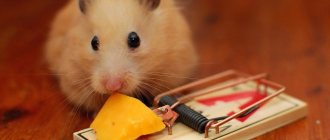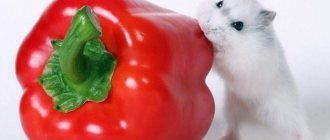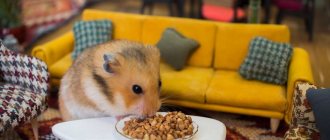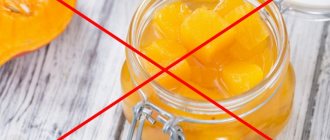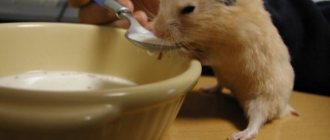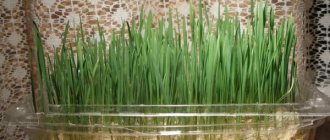Wild field hamsters in their natural habitat are omnivores; they feed on almost any plant food that comes their way. Domestic hamsters living with people do not have this opportunity. Their diet completely depends on the owner, who often offers them what he eats himself, for example, all kinds of fruits and berries. The vitamins and various microelements contained in these fruits are undoubtedly beneficial. But is it possible to pamper a hamster with them, and won’t this cause irreparable harm?
Can hamsters eat fruit?
In addition to a large supply of vitamins, fruits contain fiber, which plays an extremely important role in digestion. However, their high sugar content makes them potentially dangerous for diabetic rodents. Not all fruits are healthy and recommended for pet hamsters; some exotic fruits are strictly contraindicated.
Banana and banana chips
Bananas can be introduced into the diet of hamsters, but rather carefully, since they are very high in calories and contain a lot of sugar. This delicacy can be given no more than 1-2 times a week, and a single serving should not exceed 5-6 g (a quarter of a teaspoon). Obviously overripe and especially rotten fruits are not suitable. It is better to give preference to unripe and even slightly greenish fruits (they contain less sugar).
Overeating bananas is dangerous not only for the development of diabetes, but also for the possibility of obesity. The heart suffers from increased stress due to weight gain, and individual allergic reactions to bananas are not excluded. Sticky fruit pieces can clog your hamster's airways, sticking in the throat and other cavities of the digestive tract, causing breathing problems, choking and even death. Dry banana chips are less dangerous in this regard, but they are even sweeter and higher in calories, so you can’t give them too much. It is recommended to prepare chips yourself, since purchased products contain many different additives that are far from safe for small rodents.
It is better to avoid feeding banana skins to hamsters altogether, since the fruit is treated with chemical compounds for better preservation during transportation. These substances are extremely dangerous for all animals and can cause severe poisoning.
However, one cannot fail to note the benefits of banana; it contains the following necessary substances:
- iron - maintains hemoglobin at the proper level, restoring strength and relieving fatigue;
- potassium and magnesium - necessary for the normal functioning of the cardiovascular system, as well as the musculoskeletal system;
- phosphorus - strengthens bone and tooth tissue.
Apple and pear
Apples in moderation (no more than once a day, 10-15 g) are very beneficial for hamsters. This low-calorie fruit contains no cholesterol and has a positive effect on the body:
- strengthens the immune system, as it contains vitamins (groups B, C);
- supports the normal functioning of the cardiovascular system thanks to potassium;
- prevents cancer by being a source of antioxidants;
- improves blood composition, because it is rich in microelements (iron, phosphorus, copper, etc.).
Hamsters should not be given too many apples, as this can cause problems with the digestive system (increased gas production) and increase sugar levels. Dried pieces can be safely added to prepared food. Fresh fruit must first be washed and removed from skin and seeds. If it is bought in a store, it is better to soak it in water for 2-3 hours to remove harmful substances. Apples grown on your own plot (without the use of chemicals or pesticides) can be given with the peel. It is preferable to choose varieties with a sweet and sour taste.
Hamsters react to pears in different ways: some individuals eat it with pleasure without any negative consequences, while others feel bad. Therefore, the decision to introduce this product into the diet is made purely individually. Eating pear has the following effects:
- has a diuretic effect;
- prevents the formation of salt deposits;
- strengthens vascular walls;
- has an anti-inflammatory effect;
- helps with constipation.
The negative impact of a hamster eating a fresh fruit is irritation of the gastric mucosa, increased formation of gases, as well as possible allergic manifestations. Peel the fruit, remove the seeds, cut into small pieces of 10-12 g and give one twice a week. You can feed dried pear pieces without fear for the hamster’s health, but not more than once every couple of weeks (1-2 pieces).
Watermelon and melon
Melon crops, such as watermelon and melon, are absolutely contraindicated for hamsters. As a result of eating fruits containing a huge amount of liquid, they are guaranteed severe diarrhea. Tender fruit pulp, even if left in the feeder for a short time, deteriorates quite quickly, in which case poisoning is inevitable.
The huge amount of fertilizers and dangerous pesticides used on melons and contained in watermelons and melons is deadly for small rodents.
Apricot, peach and nectarine
Stone fruit crops (plum, cherry plum and apricot) grown in local climatic conditions can be grown for hamsters, but you just need to remove the seeds from them. Spoiled or stale fruits should not be given, as the juicy pulp quickly rots and becomes covered with dangerous fungi and bacteria. The entry of pathogens into the body is fraught with poisoning and intestinal upset.
Sweeter peach and nectarine are allowed in very small quantities (a piece of 3-4 g) and no more than 2-3 times a month strictly as an exclusive delicacy. Sugary fruits eaten in excess by a hamster can lead to weight gain and diabetes. Before consumption, all fruits should be thoroughly washed; dirty surfaces contain not only pathogens, but also worm eggs.
Plant food
Fruits in syrup, compote berries, and jam should not be offered to rodents. Any preserved food is prohibited because it contains sugar and salt. Raw seasonal fruits are preferred for feeding. Some of them are placed in the cage boiled (zucchini, beets, carrots, pumpkin). The cooking time in this case is minimal. The water is not salted.
If fresh fruits and vegetables are purchased at the store, it is better to cut off the skin (it often contains pesticides). For home harvest, this step is not necessary. Plant foods, including those from your own garden, must be thoroughly washed. After all, harmful bacteria and helminth eggs may remain on its surface.
All fruits must be fresh, not chapped, and free of rot. The pits of cherries, apples, cherries, plums, and apricots must be removed. The hamster can be poisoned by them. If a pear, pepper or other delicacy is cut into several pieces, the remaining pieces are stored in the refrigerator for several days.
It is important to remember that excessive fruit feeding causes indigestion and increased gas formation in hamsters, and increases the risk of diabetes and obesity. In small quantities, fruits help strengthen the immune system, improve intestinal motility, and are involved in the prevention of many diseases.
Citrus fruits (oranges, tangerines and lemons)
Absolutely any citrus fruits (tangerine, lemon, lime, orange, grapefruit, pomelo) cannot be given to hamsters. These fruits are harmful for the following reasons:
- a high content of vitamin C can provoke hypervitaminosis;
- acids from citrus fruits corrode tooth enamel and irritate the mucous membranes of the esophagus, stomach and intestines;
- cause allergies.
It must be remembered that both the pulp of citrus fruits and their peel are harmful. Even intensive washing is not able to wash away the chemicals used for preservation from imported fruits.
Harmful properties
Despite the benefits, strawberries can be harmful to the hamster’s body:
- Gastrointestinal system disorders.
- Intoxication.
- Pain in the intestines.
- Increased body temperature.
- In addition, the berries contain a certain amount of sucrose, which negatively affects the formation of teeth and their deformation.
- The appearance of allergies.
- Diarrhea.
- Dehydration of the body.
Dried fruits
Hamsters can occasionally be pampered with dried fruits (dried apricots, raisins, fruit chips). But you can’t get carried away with them, since the sugar content in them is high. In addition to raisins, Syrian hamsters are given a little dried apricots. For miniature jungarians, who are more prone to obesity, it is better to offer less sweet dried pieces of apples or bananas. But prunes are contraindicated for hamsters; it is better to avoid them completely.
Banana chips are already included in some ready-made feed mixtures.
Drinking fountain
Such a device can serve not only to quench the thirst of animals, but also become an original accent in the home interior.
The design consists of a water bowl, a filter, a diffuser and a drinking bowl located at the top. Additionally, it is equipped with a decorative sprinkler, especially popular with native breeds (Maine Coons, Kuril Bobtails, Siberian cats). Continuous circulation of liquid is ensured by a mini-pump powered by a USB cable. More advanced models may contain backlighting and an indication of the level of remaining water in the tank.
Cost – 2400 rub.
What berries can you give?
Juicy seasonal berries should undoubtedly be present in a hamster's diet, because they are a rich source of a wide range of vitamins and minerals. Eating them helps keep the immune system in order; you are allowed to treat:
- wild forest rowan;
- blackberries;
- strawberries;
- blueberries;
- cranberries;
- strawberries;
- white and red currants.
In very limited quantities, the hamster is occasionally given the following berries:
- lingonberries;
- blueberries;
- chokeberry;
- ripe unsweetened grapes (seedless);
- pitted cherries and cherries;
- raspberries;
- gooseberry;
- black currants.
Features of feeding strawberries to Djungarian hamsters
Djungarian hamsters and their health characteristics are somewhat different from other types of hamsters. They are susceptible to diabetes, often suffer from obesity, arthritis, and colds. Therefore, they are not recommended to eat large amounts of sweet fruits and berries.
Strawberries can be included in the diet of Djungarians, but they must be offered in small portions. In this case, the sugar contained in it will not be able to harm the health of the rodent, and its beneficial properties will have a preventive effect and increase the animal’s immunity.
IMPORTANT! Giving Djungarian hamsters sweet berries is quite risky, and it is much safer to keep them on a special diet and avoid sweets.
Strawberries during pregnancy: benefit or harm
Strawberries are a storehouse of vitamins and minerals. It contains retina, useful for digestion, vitamins of all groups C, K, B, potassium, manganese, folic acid, salicylic acid ester, copper, magnesium, iron. It is in terms of the presence of iron that this berry ranks first among all berries and fruits. Just like vitamin C, there is even more of it in strawberries than in citrus fruits. Therefore, it is believed that this berry is beneficial for expectant mothers and their unborn children.
In addition to berries, you can also eat strawberry leaves. They are especially useful for those who suffer from anemia. Also, a decoction of the leaves will help restore strength, strengthen the immune system, calm the nervous system that has become unhinged during pregnancy, and help with insomnia. Another way to use strawberry decoction is as a mouth rinse. This helps get rid of stomatitis and gingivitis. Many preparations contain strawberries or their leaves. They have wound-healing and antiseptic properties, have a good effect on blood composition and metabolism, and slow down the aging process of the skin. In addition, strawberries are an excellent preventative against cancer. In general, strawberries are a healthy berry, without a doubt.
Another thing is individual intolerance. Each person's body reacts differently to all foods. Therefore, if your mother is allergic to strawberries, it is better to refrain from eating strawberries during pregnancy, and even after it. Many doctors believe that the allergens found in strawberries can be neutralized. To do this, simply mix strawberries with milk. This unique cocktail is both tasty and healthy.
During pregnancy, a woman's hormonal background changes, which leads to changes in taste preferences and consequences. It’s better to eat a little berry and see if a rash breaks out or itches. If the body reacts normally, then you can safely eat your strawberries. But it is still advisable to control the volume of berries you eat; you should not eat kilograms of it.
In addition, many doctors advise eating strawberries not only fresh. You can make tea from strawberry berries and leaves, and strawberries and fresh milk can completely replace store-bought yogurt.
Strawberry tea is contraindicated for those girls who are at risk of uterine hypertonicity and the threat of miscarriage. It is believed that strawberry tea can increase the contraction of the uterine muscles, so it is better not to risk it.
Women with pancreatitis, those with problems with the stomach or intestines, or the gall bladder should not eat strawberries.
But maybe it’s still possible, if you’re careful
The hamster is a very curious animal and puts almost everything into its mouth. The teeth need to be ground down with something. So, if a pomegranate seed falls into his paws, he will eat it without hesitation. But, as we have already said, not everything that is useful for people is also useful for hamsters.
But it’s delicious... is it really impossible? Even a grain?
Yes, pomegranate is the king of fruits. We will modestly keep silent about Thai durian, where can you find it here? By the way, I wonder if a hamster can have durian?
Stop. We got distracted. Let's continue. The problem with pomegranate is that it is very rich in all kinds of vitamins and microelements. It is in them that its danger for the hamster lies.
For reference: pomegranate contains about 15 amino acids, five of which are essential for the body. Also, it is rich in vitamins K, C, B9 and B6 and minerals (potassium, copper, phosphorus). With all this richness, it is a low-calorie fruit. There are only 72 kilocalories in 100 grams.
So why is it so harmful to our furry pets:
- Tannins found in the fetal crust slow down the peristalsis of the intestinal tract, which leads to constipation. Considering the size of the animal and its rapid metabolism, this constipation could cost him his life. Also, the peel of the fruit contains some alkaloids, which can simply kill the poor fellow.
- The fat contained in pomegranate seeds puts a lot of stress on the liver.
- A high content of vitamins will lead to hypervitaminosis (to put it simply - too much), which is also not good for poor Khoma.
- Too much acidity in pomegranate juice is bad for the digestive system.
- Don't forget about common allergies. In the wild, hamsters are unlikely to eat pomegranate, so there is no immunity to new substances in the animal’s body. If you see that your pet is often itching, his eyes are red and tears are flowing, then most likely the poor thing is suffering from allergies or poisoning. Urgently remember what you fed and try not to give this food again.
Yes, pomegranate is a wildly useful thing, but not for hamsters.
Interesting fact: Syrian hamsters are less susceptible to pomegranate, since they still have a chance to try it in the wild. But it’s still not worth giving a Syrian a pomegranate on purpose. It’s better not to even show it to the Djungarians at all.
Conclusion
The answer to the question whether it is possible to give strawberries to hamsters will be positive. This is tasty, healthy food, but you shouldn’t overdo it. You should treat your pet with such a delicacy in moderation, carefully monitoring the baby’s health.
Don't forget to check nooks and crannies in your pet's home. Rodents often store extra food for the future, and the berries spoil very quickly. You should not allow your baby to eat a spoiled product - this is fraught with digestive disorders and even serious poisoning.
Maybe
Excessive attention from owners
Close attention and excessive care will harm not only human relationships, but can also become a reason for cannibalism in female hamsters. Since this rodent is a solitary animal, and after the birth of the cubs, the female needs a secluded environment and tranquility even more, excessive care will only harm these animals
Do not pick up hamsters and do not get into the cage. Let your family see you less.
Foreign odors repel the mother hamster. Sensing a foreign smell, she does not identify the cubs as her own creatures and, as a result, abandons them and destroys them. Do not touch the hamster family for one to two weeks after the babies are born!
It is necessary to prepare in advance for the new offspring of furry rodents. When cleaning the cage, if you find hamster supplies, do not touch them. This is a strategic supply of products, which unpleasantly traumatizes the animal’s psyche in the event of its loss, even to the point of an uneven breakdown in a pregnant female. Only spoiled products can be thrown away to avoid the growth of putrefactive bacteria, odor and poisoning.
To arrange your own nest, it is recommended to put a few paper napkins. Your task is to fill the drinking bowl with clean drinking water and pour food into the feeder on time. This is all that the rodent needs from its owner at this time. Nature will do the rest.
